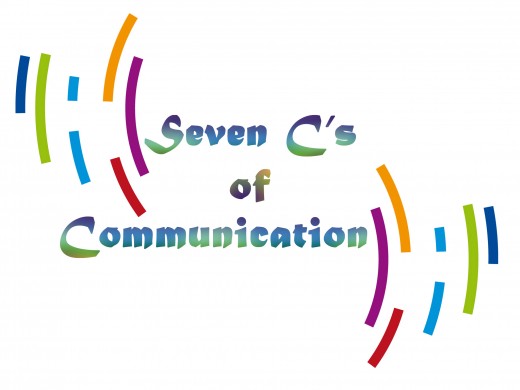Seven C's of Effective Communication

7 C's of Communication
There are seven C’s of effective communication that are relevant to oral and written communication. They are as mentioned below:
-
Completeness
-
Conciseness
-
Consideration
-
Clarity
-
Concreteness
-
Courtesy
-
Correctness

Completeness
The communication must be fully accomplished. It must express all the relevant facts that are needed by the audience. The sender must convey the message to the receiver keeping his mind set into account. Hence, a communication which is complete in itself must have the following features:
- Complete communication enhances and expands the organization’s reputation.
- Besides, it is saves money as important information is given and there is no extra cost to send more messages as the communication is finished.
- A communication which is finished always provides extra information and does not leave any doubt in the receiver’s mind.
- Complete communication helps the readers/audience/receivers make better decisions as they are now supplied with all the relevant and important information.
- It convinces the audience.

Conciseness
This means wordiness, i.e. communicating in the minimum possible words while being able to convey the meaning clearly without relinquishing the other C’s of communication. Brevity is is necessary for successful communication. The following features mark a concise communication.
- It saves both time as well as cost.
- It emphasizes and focuses on the main message while avoiding the use of unnecessary and countless words.
- Concise communication offers short and important messages to the audience in the minimum of words.
- A concise message has more appeal and is easily understood by the audience.
- A concise message does not repeat itself.

Consideration
This entails stepping into the shoes of others. For communication to be effective, the audience must be considered, i.e. the opinions of the audience, their education level, background and mind-set etc. An attempt should be made to visualize the audience, their needs, problems as well as their emotions. It is imperative to maintain the self-respect of the audience and not harm their emotions. Words in the message must be changed to suit the audience’s needs at the same time ensuring that the message is finished. Some features of considerate communication are listed below:
- Highlight the 'you' approach
- Sympathize with the audience and display an interest in them. This will encourage positive response from the audience.
- Display optimism towards the audience. Highlight on “what is possible” rather than “what is impossible”. Accentuate on positive words like committed, warm, help, jovial, thanks, healthy etc.

Clarity
This entails stressing on a particular message or goal at a time rather than making an attempt to attain too much at one time. Clarity in communication has the following distinct features:
- It makes comprehension easier.
- The meaning of the message is augmented by an absolute clarity of thoughts and ideas.
- A clear message will use precise, suitable and distinct words.

Concreteness
A concrete communication entails being specific and transparent rather than blurry and general. Concreteness enhances faith. A concrete message is distinguished by the following:
- It is reinforced with precise facts and figures.
- It uses words that have clarity and develops the reputation.
- Concrete messages cannot be misconstrued.

Courtesy
Courtesy in message means that the message should indicate the sender’s expression while respecting the receiver. The dispatcher of the message should be genuinely polite, sensible, thoughtful and passionate. Courteous message has the following characteristics:
- Courtesy involves considering the opinions and the thoughts of the receiver of the message.
- A courteous message is optimistic and is concentrated at the audience.
- It uses language which is respectful towards the receiver of the message.
- It is completely unbiased.

Correctness
Correctness in communication means that there are no grammatical mistakes in the communication. Correct or proper communication has the following characteristics:
- The message is precise, accurate and timely.
- A correct communication boosts up the confidence levels.
- A correct message creates a better impression on the audience/readers.
- It verifies the accuracy and exactness of facts and figures used in the message.
- It uses suitable and acceptable language in the message.







